Related Research Articles
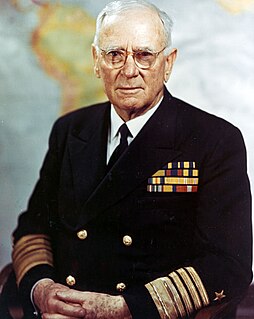
William Harrison Standley was an admiral in the United States Navy, who served as Chief of Naval Operations from 1933 to 1937. He also served as the U.S. ambassador to the Soviet Union from 1941 until 1943.
USS Dallas (DD-199) was a Clemson-class destroyer in the United States Navy during World War II. She was the second ship named for Captain Alexander J. Dallas, and was later renamed Alexander Dallas.

USS Fox (DD-234/AG-85) was a Clemson-class destroyer in the United States Navy during World War II. She was the fourth ship named for Gustavus Vasa Fox, Assistant Secretary of the Navy during the Civil War.

USS Mason (DE-529), an Evarts-class destroyer escort, was the second ship of the United States Navy to be named Mason, though DE-529 was the only one specifically named for Ensign Newton Henry Mason. USS Mason was one of two US Navy ships with largely African-American crews in World War II. The other was USS PC-1264, a submarine chaser. These two ships were manned by African Americans as the result of a letter sent to President Roosevelt by the NAACP in mid-December 1941. Entering service in 1944, the vessel was used for convoy duty in the Battle of the Atlantic for the remainder of the war. Following the war, Mason was sold for scrap and broken up in 1947.
Gus George Bebas was an American naval aviator and a recipient of the Distinguished Flying Cross. He was killed during World War II after losing control of a plane during a practice dive in Hawaii. The USS Bebas (DE-10) was named in his honor.
Lieutenant Commander William Ellison Pennewill, born in Dover, Delaware, 20 February 1907, was an aviator of the United States Navy, killed on 23 June 1942, as a result of a crash.
John Drayton Baker was an American Naval aviator who was awarded the Navy Cross for his actions during World War II.
Clark Franklin Rinehart was born in Ridgeway, Missouri, 30 May 1910.

Edward Robert Sellstrom was a Naval aviator who died while in service with the United States Naval Reserve during World War II.
No. 233 Squadron RAF was a Royal Air Force squadron that operated from 1918–1919, 1937–1945, 1952–1957 and 1960–1964. The squadron was formed from several Royal Naval Air Service (RNAS) flights and took part in the tail end of the First World War before being disbanded. The squadron was reformed with the advent of World War II. At first No. 233 Squadron flew general reconnaissance patrols before being tasked with transportation duties just prior to D-Day. Shortly after the Second World War the squadron was again disbanded, to be reformed once more in 1960. No. 233 Squadron was finally disbanded in 1964.
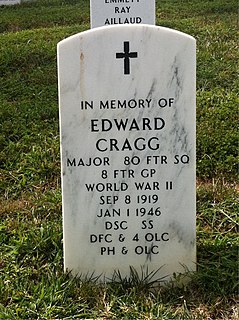
Edward "Porky" Cragg was a triple ace and a major in the United States Army Air Forces.
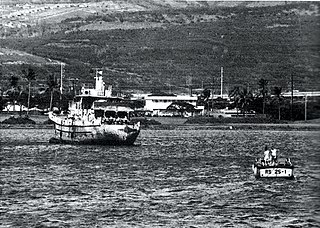
USS Buckeye (AN-13/YN-8) was an Aloe-class net laying ship in service with the United States Navy from 1942 to 1947. In the late 1970s and 1980s, she was used as a salvage training hulk.

USS Matagorda (AVP-22/AG-122) was a United States Navy Barnegat-class seaplane tender in commission from 1941 to 1946 that saw service in World War II. After the war, she was in commission in the United States Coast Guard as the cutter USCGC Matagorda (WAVP-373), later WHEC-373, from 1949 to 1967.
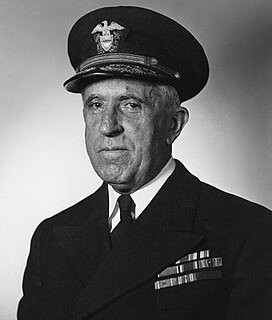
Herbert Fairfax Leary was a highly decorated officer in the United States Navy with the rank of vice admiral. A son of Rear Admiral Richard P. Leary, he distinguished himself during World War I while on the staff of Commander, U.S. Naval Forces in Europe under Admiral William Sims and received the Navy Cross, the United States Navy's second-highest decoration awarded for valor in combat.
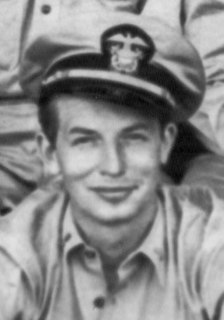
Oswald A. Powers (1915–1942) was a United States Navy officer who received the Navy Cross posthumously for his actions in combat during World War II.

Curtis William Howard was a United States Navy officer who received the Navy Cross posthumously for his actions during the Battle of Midway during World War II.

Rear Admiral Herbert James Ray was an officer in the United States Navy who served in World War I and World War II. A 1914 graduate of the Naval Academy, he served on the submarines USS H-2 and N-3 during World War I. In March 1942, as Chief of Staff and Aide to the Commandant of the Sixteenth Naval District, Rear Admiral Francis W. Rockwell, he participated in General Douglas MacArthur's escape from the Philippines. In Australia, he served with MacArthur's General Headquarters, Southwest Pacific Area staff. In September 1943, he became Captain of the battleship USS Maryland, which he commanded in the Battle of Tarawa, Battle of Kwajalein, Battle of Saipan and the Battle of Peleliu. In October 1944, he participated in the Battle of Surigao Strait, in which Maryland joined the other battleships in engaging the Japanese battleships Fusō and Yamashiro and their escorts. Ray left Maryland in December 1944, and was promoted to Commodore and appointed Deputy Director of the Naval Division of the US Control Group Council for Germany. After VE Day, he became the Junior United States Member of the Tripartite Naval Commission in Berlin. He retired from the Navy on 30 June 1949, and received a tombstone promotion to rear admiral due to his combat decorations.
Charles Perry Mason was an American Vice Admiral of the United States Navy and an early naval aviator. He was the Mayor of Pensacola from 1947 to 1957 and again from 1963 to 1965.
VPB-91 was a Patrol Bombing Squadron of the U.S. Navy. The squadron was established as Patrol Squadron 91 (VP-91) on 1 December 1941, redesignated as Patrol Bombing Squadron 91 (VPB-91) on 1 October 1944 and disestablished on 2 April 1946.
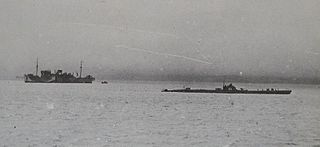
I-71, later I-171, was a Kaidai-class cruiser submarine of the KD6 sub-class built for the Imperial Japanese Navy during the 1930s. She served in World War II, and took part in operations supporting the attack on Pearl Harbor, the Battle of Midway, and the Aleutian Islands campaign. She was sunk in February 1944.
References
This article incorporates text from the public domain Dictionary of American Naval Fighting Ships .
| | This biographical article related to the United States Navy is a stub. You can help Wikipedia by expanding it. |